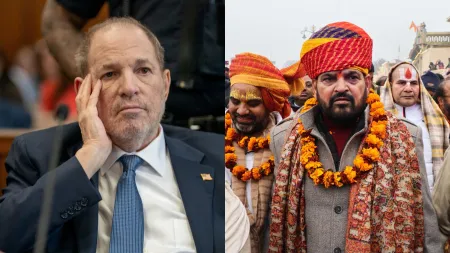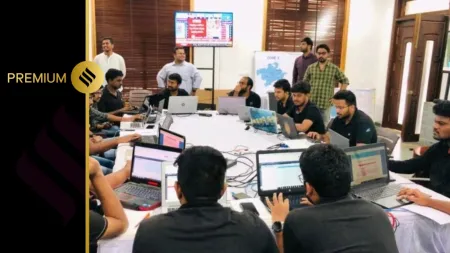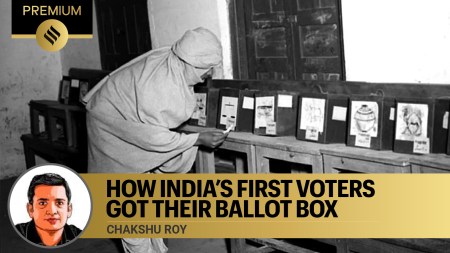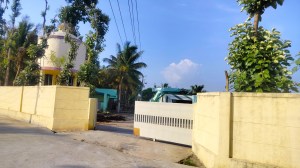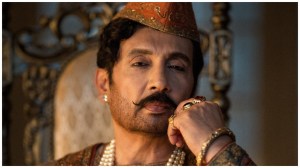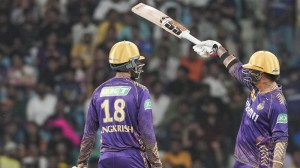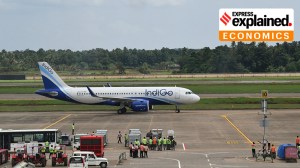- India
- International
A short history of the Krishna Janmasthan temple in Mathura
The first major Vaishnava temple at the site was probably built 2000 years ago. In 1670, Aurangzeb destroyed the Keshavdev temple at the Janmasthan. The Allahabad High Court has ordered a survey of the Shai Idgah mosque, which was allegedly built on top of the temple.
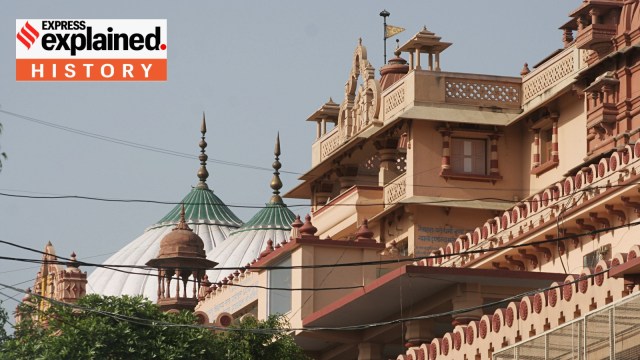 Shri Krishna Janmabhoomi Mandir and the Shahi Idgah mosque in Mathura. (Express archives photo by Partha Paul)
Shri Krishna Janmabhoomi Mandir and the Shahi Idgah mosque in Mathura. (Express archives photo by Partha Paul)The Supreme Court on Friday (December 15) declined to stay an order issued by the Allahabad High Court a day earlier allowing a survey of the Shahi Idgah mosque in Mathura, believed to have been built at Krishna Janmasthan, the site where Lord Krishna was born.
The mosque was built in the 17th century during the reign of the Mughal Emperor Aurangzeb. The application filed by Hindu petitioners who asked for the survey said that “it is a matter of fact and history that Aurangzeb…issued orders for demolition of a large number of Hindu religious places and temples including the temple standing at the birth place of Lord Shree Krishna…”
Here’s the history of the site and the mosque, based on what the historical record says.
The first temple at the site was built 2,000 years ago, in the 1st century CE.
Located in the heart of Braj, along the banks of the Yamuna, Mathura assumed importance as a trading and administrative hub during the time of the Mauryas (4th to 2nd centuries BCE).
For pilgrims, the most important site in Mathura was the Krishna Janmasthan, the birthplace of Lord Krishna. The historian A W Entwistle recorded that the first Vaishnava temple at the Krishna Janmasthan site was probably built in the 1st century CE, and a grander temple was constructed during the reign of Chandragupta II, also known as Vikramaditya, around 400 CE (Braj: Centre of Krishna Pilgrimage, 1987).

Alexander Cunningham (1814-93), the first archaeologist of British India and founder director general of the Archeological Survey of India (ASI), believed that the site originally contained Buddhist structures that were destroyed, and some of the material was used to build the Hindu temple. Excavations in the area have uncovered remains of a large Buddhist complex.
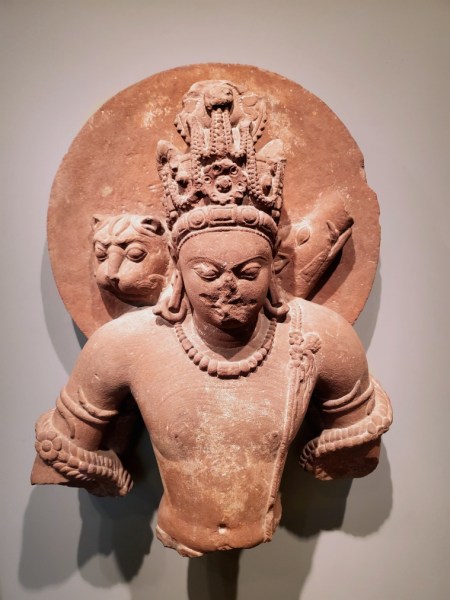 The God Vishnu in Three Incarnations. Northern India (Mathura), Gupta period, mid-5th century CE. Currently in Boston Museum. (Wikimedia Commons)
The God Vishnu in Three Incarnations. Northern India (Mathura), Gupta period, mid-5th century CE. Currently in Boston Museum. (Wikimedia Commons)
Through the first millennium CE, the temple at Krishna Janmasthan attracted devotees from across the subcontinent. Buddhist and Jain sites appear to have existed alongside, and ancient Mathura remained a major Buddhist and Jain centre till the end of the first millennium CE. Chinese pilgrims Fa Hien/ Faxian (337-422 CE) and Hiuen Tsang/ Xuanzang (602-664 CE), and even later Muslim chroniclers described stupas and monasteries in Mathura.
The temples were attacked several times, but they could not be destroyed.
Mahmud of Ghazni, sultan of the Persianate Ghaznavid empire from 998 to 1030 CE, made a series of plundering raids into India from the beginning of the 11th century. In 1017 or 1018 CE, Mahmud showed up in Mathura and, according to the account of the historian Mahomed Kasim Ferishta (1570-1620), stayed for about 20 days. During this time, “the city suffered greatly from fire, besides the damage inflicted by pillage,” Ferishta wrote.
The Jain and Buddhist centres, which were already in decline, did not survive the onslaught by Mahmud. But the worshipers of Krishna — referred to as Vasudeva by the Khwarizmian historian and polymath Al-Biruni (973-c. 1050 CE) — were more resilient. Writing a few years after Mahmud’s pillage, Al-Biruni mentioned Mathura as one of the foremost places of pilgrimage in India, “crowded with Brahmins”.
An inscription in Sanskrit dated to about 1150 CE records the foundation of a Vishnu temple at the site where the Katra Keshavdev temple now stands. This temple at the Krishna Janmasthan was “brilliantly white and touching the clouds”, says the inscription.
This magnificent temple would eventually be knocked down by Sikandar Lodhi (1458-1517), the sultan of Delhi. This was part of a pattern of destruction seen during the Delhi Sultanate (1206-1526), Entwistle wrote — almost everything “that was built by Buddhists, Jains, and Hindus was either abandoned and left to collapse into ruins, or was destroyed by Muslim iconoclasts.”
Interestingly, it is this decline that contributed to the emergence of a new form of Vaishnavism in the region. The likes of “Nimbarka, Vallabha, and Chaitanya are thought to have inspired the reclamation of Braj,” Entwistle wrote.
These Vaishnava Bhakti saints from southern and eastern India preached an intensely emotional and personal form of Krishna worship, and the general understanding of Vaishnavism today is rooted in their teachings, the existence of numerous sectarian differences notwithstanding.
The temples of Mathura saw a resurgence under the early Mughal rulers.
The defeat of Ibrahim Lodhi at the First Battle of Panipat in 1526 led to the foundation of the Mughal dynasty. The Mughals’ tenuous hold over power under Babur and Humayun in the early decades, along with the aforementioned religious movements, led to a spurt in religious activity in Braj. While no large temples were not built, mostly for economic reasons and the absence of rich royal patrons, numerous smaller shrines to Lord Krishna came up in Mathura and nearby Vrindavan.
Things improved further during the long reign of Akbar (1556-1605). Historians Tarapada Mukherjee and Irfan Habib (among others) have written about a number of land and revenue grants that the emperor made to temples of various Vaishnavite sects in Mathura (‘Akbar and the Temples of Mathura and its Environs’, Proceedings of the Indian History Congress, 1987).
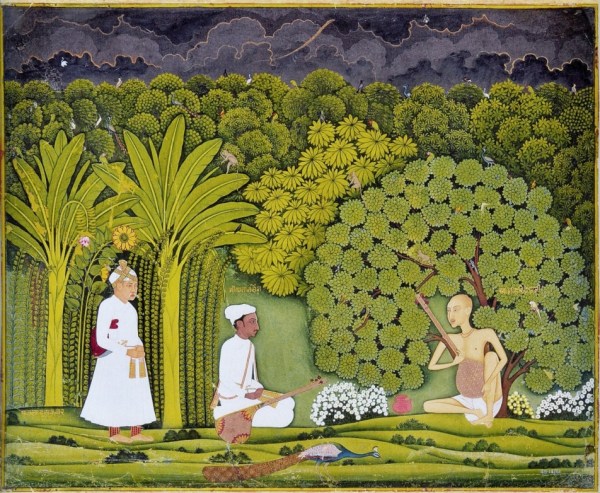 Akbar (left) and Tansen (centre) visit Swami Haridas in Vrindavan. SWAMI Haridas was Tansen’s teacher. Jaipur-Kishangarh mixed style, c. 1750 (Wikimedia Commons)
Akbar (left) and Tansen (centre) visit Swami Haridas in Vrindavan. SWAMI Haridas was Tansen’s teacher. Jaipur-Kishangarh mixed style, c. 1750 (Wikimedia Commons)
Akbar, who had a liberal and tolerant outlook towards other religions and showed great curiosity about them, personally visited Mathura and Vrindavan on at least three occasions, and is supposed to have met religious figures such as Swami Haridas (1483-1573). Rajputs and other Hindus in high positions in the Mughal administration helped build new temples and restore old ones.
In 1618, during the reign of Akbar’s son Jahangir, Raja Veer Singh Deo, the Rajput ruler of the Orchha kingdom that was a vassal state of the Mughal Empire, built a grand temple at the Katra site in Mathura.
This temple, which was described by the French traveller Jean-Baptiste Tavernier who visited Mathura in 1650, was octagonal in shape, and built with red sandstone. The Venetian traveller Niccolao Manucci, who visited Mathura in the late 1650s, wrote that the temple was “of such a height that its gilded pinnacle could be seen from Agra”.
Dara Shikoh, Jahangir’s grandson and the eldest son of Shah Jahan, who was a great champion of religious coexistence in the empire, ordered renovations to the site, including the installation of a stone railing around it.
But the temple was ultimately destroyed by the order of Aurangzeb.
Dara, the heir apparent of Shah Jahan, was declared an apostate and killed in 1659 by Aurangzeb, who had seized power by then. Aurangzeb was a stern, austere, and devout Muslim, quite the opposite of Dara in religious personality.
In 1660, Aurangzeb appointed Abdul Nabi Khan, who was intensely unpopular with the Hindu subjects of the empire, the governor of Mathura. In 1661-62, Khan built the Jama Masjid at the location of the temple that had been destroyed by Sikandar Lodhi. In 1666, he destroyed the railing built by Dara Shikoh around the Keshavdev temple.
In 1669, Aurangzeb issued a royal farmaan ordering the destruction of all Hindu schools and temples, across the Mughal Empire. The Kashi Vishwanath temple in Kashi was destroyed after the farmaan was issued.
In 1670, he specifically ordered the destruction of Mathura’s Keshavdev temple, and sponsored the construction of the Shahi Idgah in its place. Jadunath Sarkar, author of the monumental five-volume History of Aurangzib, wrote that the temple’s deities were taken to Agra and buried.
Historian-activist Audrey Truschke, author of Aurangzeb: The Man and the Myth (2017), sought to find an explanation for Aurangzeb’s actions that went beyond just religious intolerance and bigotry: “Mathura Brahmins may have assisted with Shivaji’s 1666 flight from Agra. Moreover, the Keshava Deva Temple had been patronised by Dara Shukoh, Aurangzeb’s major rival for the throne. More immediately, Jat uprisings in the region in 1669 and 1670 dealt the Mughals heavy casualties [including the murder of Abdul Nabi Khan in 1669].”
The major temples of Mathura today were finally built after Independence.
By 1803, Mathura passed under the control of the British East India Company. In 1815, the Company auctioned 13.37 acres of land at the Katra Keshavdev site to Raja Patnimal, a wealthy banker from Varanasi. It is this piece of land that is the subject of the ongoing litigation, with the Hindu side claiming that it included the Shahi Idgah mosque while the Muslim side saying that it did not.
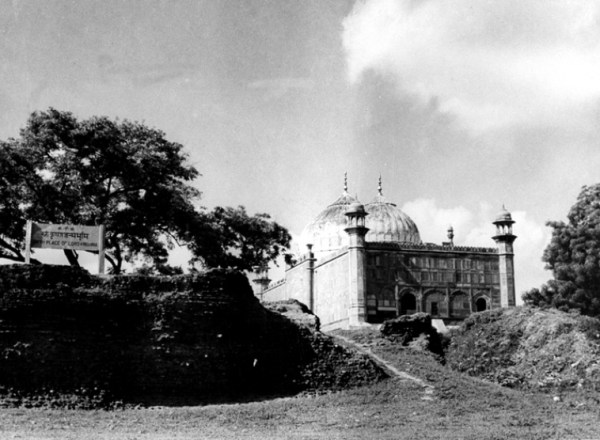 The site of the present day temple in 1949. We can see the Idgah right next to it. Construction of the current temple began in 1953. (Photo: Government of India)
The site of the present day temple in 1949. We can see the Idgah right next to it. Construction of the current temple began in 1953. (Photo: Government of India)
Raja Patnimal wanted to build a temple at the site, but was prevented by a lack of funds. Subsequently, his descendants were slapped with a number of lawsuits centred on the land. In 1944, they ended up selling the land to industrialist Jugal Kishore Birla who, in 1951, formed the Shri Krishna Janmabhoomi Trust to facilitate the construction of a temple at the site.
Construction started in 1953, and was funded by industrialists and business families of India. Construction was completed in 1983, when the temple took its present shape, adjacent to the Shahi Idgah mosque.
More Explained
EXPRESS OPINION
May 06: Latest News
- 01
- 02
- 03
- 04
- 05





